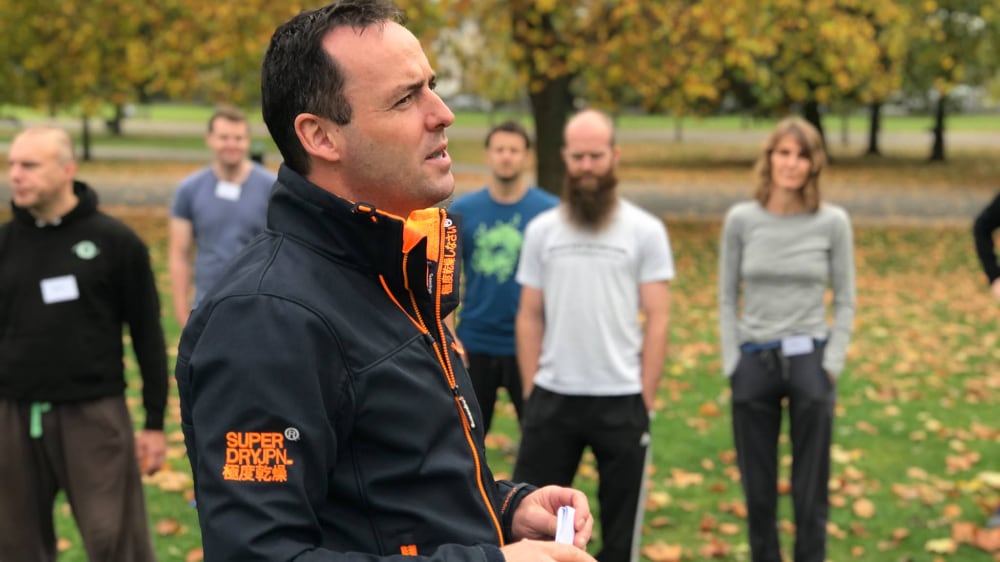Breathwork · How I started
As a teenager, I vividly recall my daily walk from the bus stop to school in Synge Street, Dublin. Throughout this twenty-minute journey, my mind would drift incessantly from one thought to another, rendering me on autopilot. While physically present on the street, my mental focus remained elsewhere. Lost in contemplation, my attention was ensnared by past events or potential future scenarios, akin to a broken record in repeat mode.

I am certain that, during those walks, I habitually breathed through my mouth, a result of years of nasal congestion. The connection between mouth breathing and my tendency to overthink will be unveiled shortly.
In the late 1990s, I was fortunate to discover three practical techniques invaluable in silencing my overactive mind and breaking free from the cycle of perpetual overthinking. These methods have endured the test of time and continue to be integral to my daily practice. If you, like me, have grappled with a mind lost in incessant thoughts, these approaches may offer you practical means to redirect your focus and cultivate a sense of stillness.
Breathwork in practice
The first involves learning to breathe exclusively through the nose. The second is shifting attention from the mind to the breath, and the third is anchoring attention in the present moment. If I were to quantify the reduction in my thinking habit, I would estimate it at about 50%. Indeed, it is possible to decrease thought activity. Nowadays, I don’t find myself nearly as often trapped in my own thoughts. A quieter mind translates to a happier mind.
Walking serves as an excellent activity to diminish thought activity. It is not merely physical training but a means to train both breathing and the mind.
There is a time for planning and decision-making, an essential aspect of being human. However, there is also a time to cease thinking and immerse oneself in the unfolding of life. This, too, is fundamental to our humanity but often overlooked. Walking while lost in thought is a missed opportunity to experience life and instill a calmness that extends beyond the act of walking.

As you embark on your walk, contemplate the importance of avoiding a distracted stroll ensnared in your thoughts. Utilize this time to be present, observing nature and life as they unfold around you. It’s not about mysticism; it’s a straightforward choice. You can either walk with your mind dwelling on past events or worrying about the future, or you can take a walk and keenly observe your surroundings.
Breathing exclusively through the nose offers distinct advantages. It facilitates efficient oxygen transfer from the lungs to the bloodstream and enhances the delivery of oxygen from the blood to the body’s tissues. Notably, though the brain constitutes only 2% of body weight, it demands a substantial 20% of the body’s oxygen supply.
When engaging in brisk walking with nasal breathing, there is a noticeable elevation of carbon dioxide in the blood. This elevation triggers an impressive 8 to 10% increase in blood flow to the brain. A seminal paper from 1988, recently referenced by neuroscientist Dr. Andrew Huberman, highlights that increased carbon dioxide levels lower blood pH, contributing to the regulation of brain cell excitability.1 The outcome is a calmer and more focused mind, marked by reduced random and irrelevant thinking. The practical implication is clear: incorporating physical exercise with nasal breathing can effectively minimize the influx of distracting thoughts. Essentially, as the brain manages breathing, it actively governs its own level of excitability, showcasing the potential to achieve a more composed and concentrated state of mind.
Pause for a moment to consider what’s housed in your mouth – the teeth, palate, jaws, tongue, and throat. Surprisingly, these play no role in the act of breathing. The mouth merely acts as a passageway, permitting cold, dry, and unfiltered air to flow into the lungs.
In stark contrast, the nose serves a dynamic purpose. It conditions, warms, moistens, and even produces nitric oxide—a vital gas that facilitates the opening of airways, helps ward off colds, and improves the transfer of oxygen. Nasal breathing is the natural and optimal way for both humans and animals to breathe, evident in the animal kingdom where creatures like racehorses and cheetahs instinctively breathe through their noses, even during high-intensity activities.

Despite the clear advantages of nasal breathing, many fall into the habit of mouth breathing, particularly during walking. It feels easier to breathe through the mouth during exercise, as the sensation of air hunger is less pronounced. However, easier does not always mean better.
Transitioning from mouth to nasal breathing during exercise might initially intensify the feeling of air hunger. The nasal passages, being smaller than the mouth, naturally impose resistance, slowing down the breathing process. This deliberate deceleration allows sufficient time for oxygen to transfer from the lungs to the blood. Additionally, slower breathing induces a state of relaxation. Despite the initial discomfort, this heightened air hunger should be seen as a beneficial training load for the respiratory system.
Over a few weeks, the feeling of air hunger diminishes, and the body becomes more efficient, accomplishing more with less effort. Controlled nasal breathing not only enables individuals to move faster but also fosters a sense of vitality and accomplishment, making the overall exercise experience more enjoyable.
The second technique involves redirecting attention to the breath. Amidst the chaos of the mind, consciously tuning in to the rhythm of your breath serves as an anchor to the present moment. There are four places where breathing can be felt in the body. The first is the area just inside the nose; the second is the back of the throat; the third is the upper chest, and the fourth is the area of the diaphragm.
As you walk, bring your attention to your breathing and feel the slightly colder air coming into the nose and the slightly warmer air leaving the nose. When your attention is on your breath, it is out of the head. There are times that the mind wanders, and noticing this is an important part of your quest to achieve mastery over the mind. Each time the mind wanders, bring attention back to your breathing. With each inhalation and exhalation, you create a steady cadence, pulling your awareness away from the mental chatter. You could take this one step further and shift attention throughout the body. This merely involves bringing your attention into various parts of the body as you walk. Feel the weight of your feet against the ground, the clothes against your skin and the subtle energy of the body. This deliberate act of turning inward allows you to escape the tumult of the mind and find a sanctuary within your own physical presence.
The third technique involves immersing yourself in the present moment. Rather than being carried away by the stream of thoughts, redirect your attention to the immediate surroundings.
During your walk, shift your attention from the mind and experience life as it unfolds around you. By using the senses—sight, sound, touch, smell, and taste—walks become immersive journeys. As human beings, we experience life through our senses. On the other hand, we do not experience life if our attention is stuck in our head. The next time you go for a walk, check where your attention is. Are you lost in thought, merely going through the motions of being in nature in body, but not in mind?
Rather than viewing the world through a mental filter, take a moment to look around and connect with the grass, trees, sky, and ground. It’s about making a conscious decision to be aware of your environment. Pay attention to the sounds, whether it’s the impact of each step on the ground, the wind brushing through the trees, or the gentle swaying of grass. This isn’t about fancy experiences; it’s a practical way to ground yourself and appreciate the simple elements of your surroundings during your walk.
As you explore these techniques, it’s important to recognize that each individual may resonate more with one approach than the others. Perhaps you find solace in the rhythmic dance of your breath, the grounded awareness of your body, or the immersive experience of the present moment. There’s no need for self-imposed pressure; the key is to go easy on yourself as you gently guide your attention away from the dominance of the mind.
Acknowledging that the mind has held sway for many years, we understand that relinquishing control is a gradual process. Even in the midst of a nature walk, where the intention is to be free from the chains of thought, the mind may sneak back in. Regularly checking in with your attention serves as a compass, guiding you back on course each time it veers off into the realm of thoughts.
It’s crucial to dispel any notion of achieving a specific goal through these practices. The objective is not to attain a particular state but to create a space for stillness and presence. Remember, the journey of bringing your attention out of the head is ongoing, and the more you cultivate this awareness, the more likely you are to maintain your course amidst the ebb and flow of the mind’s activity. Each instance of gently redirecting your attention is a victory in itself, contributing to a more centered and mindful existence. Walk yourself Happy!
Notes:
Balestrino M, Somjen GG. Concentration of carbon dioxide, interstitial pH and synaptic transmission in hippocampal formation of the rat. J Physiol. 1988 Feb;396:247-66.
